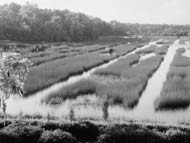The Evolution of Rice Technology
In 1710, Thomas Nairne, the colony’s first Indian agent and an experienced planter, stated in a promotional pamphlet that anyone interested in establishing a rice plantation could do it with an investment of £1,000 Sterling. With such capital, a would-be planter could acquire a 1,000-acre plantation, approximately 30 slaves, all the equipment and necessary housing, livestock, and provisions for a year. A gentleman could expect an annual rate of return of £200 Sterling on his investment. Indeed from 1700 to 1770 rice production increased dramatically and great fortunes were made.
Unfortunately, Nairne offered little information or advice about how construction of a rice plantation was accomplished. Indeed, there are very few early descriptions of rice fields, particularly inland rice fields. Most historians draw upon Robert F. W. Allston’s 1843 treatise on the introduction and production of rice in Carolina to understand how inland rice production flourished and later was replaced by tidal agriculture.
“These low grounds being found to agree better with the plant, the inland swamps were cleared for the purpose of extending the culture. In the process of time as the fields became too grassy and stubborn, they were abandoned for new clearings; and so on until at length was discovered the superior adaptation of the tide-lands, and the great facilities for irrigation afforded by their location. For these, the inland plantations were gradually and slowly abandoned, until now, that the great body of land, which little more than a century ago furnished for exportation over 50,000 barrels of Rice, now lies utterly waste.”
Robert Allston 1843
Recent research and the results of the rice field study sponsored by Charleston County helped researchers set out this overview of the evolution of rice field construction from its earliest beginnings until the end of commercial rice production in the Lowcountry after the Civil War.
1690-1710 — Rice was sown in wet ground with little physical improvement to the swamps. Planters with enough slaves began to experiment with swamp reclamation, which entailed dam and ditch building. Rice strains were still in an experimentation phase.
1710-1740 — Slave importation increased dramatically, bringing more skilled rice farmers to the colony. Plantations grew in size and took in more and more inland swamps. Dams and ditches became more advanced. Rice was hand processed.
1740-1760 — Despite unstable prices and an unfavorable market, plantations grew in size and number, as did slave imports. Rice was adapted to larger savanna lands that were harder to control and more marginal than the smaller swamps. Planters began to experiment and had their slaves build inland fields along freshwater creeks with tidal influence. Enslaved people still processed rice by hand.
1760-1780 — Inland swamp plantations reached their zenith during this period. Engineering was perfected to handle any kind of swamp. The trunks in fields were advanced and could handle many water systems and environments. The development of canals and public drains began at the end of this period. With inland technology perfected, the move to rivers for tidal agriculture began.
1780-1820 — Canal development grew and expanded across the Lowcountry, which helped large inland swamp plantations to remain competitive with tidal plantations. Tidal experimentation moved rapidly to perfection. European engineers provided new expertise for better embankment techniques and drainage improvements. The advancement and growth of rice mills provided quicker, mechanized grain processing. At the end of this period, inland rice was mostly abandoned.
1820-1865 — Access to steam mills was widely available. Trunks were perfected. Inland fields were abandoned. Rice plantations were consolidated, with fewer planters owning more and more plantations and slaves. At the end of this period, slavery was abolished which nearly ended rice cultivation.
1865-1920 — Slave labor ended. Paid workers began to work in rice fields. By the 1890s, tidal planting was nearly abandoned completely. Innovative planters found advancements in mechanized labor, as well as the mechanization of trunks. Freed Africans took rice technology into their local areas and utilized unaltered swamps for growing rice. Technology reverts back to the 1690-1710 period when rice was grown in low, wet, unaltered swamp land.
“I viewed with pleasure this gentleman’s exemplary improvements in agriculture: particularly in the growth of rice… which stands in the water almost from the time it is sown, until within a few days before it is reaped, when they draw off the water by sluices, which ripens it all at once”
William Bartram, 177X


